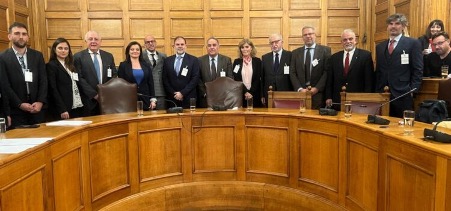In November 2023, partners at CERTH/CPERI presented their work on CCUS technologies to the Environment Committee at the Hellenic Parliament.
Nikolaus Koukouzas, Director of Research at CERTH/CPERI, and Researcher and Business Development Manager Pavlos Tyrologou described the current status of CCUS in Europe and the rest of the world to Members of the Hellenic Parliament.
“We explained that CCUS are important technologies, particularly in Southern Europe to reduce CO2 emissions from lignite-fired power plants, refineries, cement and steel industries in Greece and other Balkan countries,” says Koukouzas.
Greece’s promising CO2 storage capacity means it could offer CO2 storage solutions to neighbouring countries. “Greece could become a CO2 hub, where captured CO2 from industrial emissions is transferred by pipeline or ship to geological storage sites,” Koukouzas adds.
At present, efforts are focused on two major sites. One is offshore, consisting of depleted oil and gas fields in the Prinos area, in the northern part of the Aegean Sea; the other is the onshore Mesohellenic Trough, located in northwestern Greece.
The Mesohellenic Trough, which is being characterized as part of the PilotSTRATEGY project, is estimated to have a CO2 storage capacity of up to 1 gigatonne (Gt) in the Pentalofo Formation and of up to 0.85 Gt in the Eptachori Formation1.
Members of the Hellenic Parliament asked questions about the viability, cost and environmental impact of CCUS technologies.
“We explained that CCUS does not have adverse effects on the environment, but quite the opposite since removing CO2 from the atmosphere will have a positive effect on mitigating climate change, and that the costs are dependent on the different conditions of capture, transport and storage,” says Koukouzas.
As a result of the meeting, the Environment Committee expressed an interested in getting more information on CCUS, particularly regarding techno-economic and socio-economic details as well as on the required legislative frameworks.
“Things are definitely moving in Greece; representatives of the Hellenic Hydrocarbons and Energy Resources Management Company responsible for hydrocarbons and CO2 storage permits, who were also present at the meeting, will start developing the legislation for CCUS, and with funding from the European Commission, preparations to inject captured CO2 at the Prinos site have commenced,” Koukouzas says.
According to Koukouzas, the priorities now are to further investigate the potential of the Mesohellenic Trough for CO2 storage and to build social acceptance of CCUS technologies. He is optimistic about recent developments and the contributions of the PilotSTRATEGY project to advancing CCUS in Greece.
“As CCUS technologies mature they offer the opportunity to mitigate climate change while creating more well-paid jobs. In ten years’ time, together with hydrogen storage, they will contribute to advance a more sustainable society,” Koukouzas concludes.
Reference:
1. A. Tasianas, N. Koukouzas. CO2 storage capacity estimate in lithology of the Mesohellenic Trough, Greece. Energy Porcedia (86) (2016), pp. 334-341



